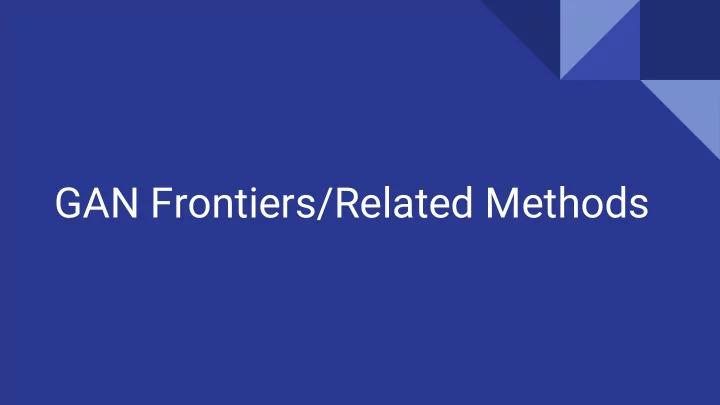

GAN Frontiers/Related Methods
Improving GAN Training Improved Techniques for Training GANs (Salimans, et. al 2016) CSC 2541 (07/10/2016) Robin Swanson (robin@cs.toronto.edu)
Training GANs is Difficult ● General Case is hard to solve ○ Cost functions are non-convex ○ Parameters are continuous ○ Extreme Dimensionality ● Gradient descent can’t solve everything ○ Reducing cost of generator could increase cost of discriminator ○ And vice-versa
Simple Example ● Player 1 minimizes f(x) = xy ● Player 2 minimizes f(y) = -xy ● Gradient descent enters a stable orbit ● Never reaches x = y = 0 (Ian Goodfellow, Yoshua Bengio, and Aaron Courville. Deep Learning. 2016. MIT Press)
Working on ● Feature Mapping ● Minibatch Discrimination ● Historical Averaging Converging ● Label Smoothing ● Virtual Normalization
Feature Matching ● Generate data that matches the statistics of real data ● Train generator to match expected value of intermediate discriminator layer: (Where f(x) is some activations of an intermediate layer) ● Still no guarantee of reaching G* ● Works well in empirical tests
Minibatch Discrimination ● Discriminator looks at generated examples independently ● Can’t discern generator collapse ● Solution: Use other examples as side information ● KL divergence does not change ● JS favours high entropy (Ferenc Huszár - http://www.inference.vc/understanding-minibatch-discrimination-in-gans/)
And More... ● Historical Averaging: ● Label Smoothing: ○ e.g., 0.1 or 0.9 instead of 0 or 1 ○ Negative values set to zero ● Virtual Batch Normalization: ○ Each batch normalized w.r.t a fixed reference ○ Expensive, used only in generator
Assessing Results
Ask Somebody ● Solution: Amazon Mechanical Turk ● Problem: ○ “TASK IS HARD.” ○ Humans are slow, and unreliable, and … ● Annotators learn from mistakes (http://infinite-chamber-35121.herokuapp.com/cifar-minibatch/)
Inception Score ● Run output through Inception Model ● Images with meaningful objects should have a label distribution (p(y|x)) with low entropy ● Set of output images should be varied ● Proposed score: ● Requires large data sets (>50,000 images)
Semi-Supervised Learning
Semi-Supervision ● We can incorporate generator output into any classifier ● Include generated samples into data set ● New “generated” label class ○ [Label 1 , Label 2 , …, Label n , Generated] ● Classifier can now act as our discriminator (Odena, “Semi-Supervised Learning with Generative Adversarial Networks” -- https://arxiv.org/pdf/1606.01583v1.pdf)
Experimental Results
Generating from MNIST Semi-Supervised generation without (left) and with (right) minibatch discrimination
Generating from ILSVRC2012 Using DCGAN to generate without (left) and with (right) improvements
Where to go from here
Further Work ● Mini-batch Discrimination in action: https://arxiv.org/pdf/1609.05796v1.pdf Generating realistic images of galaxies for telescope calibration ○ ● MBD for energy based systems: https://arxiv.org/pdf/1609.03126v2.pdf ○
Adversarial Autoencoders (AAEs) Adversarial Autoencoders (Makhzani, et. al 2015) CSC 2541 (07/10/2016) Jake Stolee (jstolee@cs.toronto.edu)
Variational Autoencoders (VAEs) ● Maximize the variational lower bound (ELBO) of log p( x ) : } } Divergence of q from prior Reconstruction quality (regularization)
Motivation: an issue with VAEs ● After training a VAE, we can feed samples from the latent prior ( p( z ) ) to the decoder ( p( x | z ) ) to generate data points ● Unfortunately, in practice, VAEs often leave “holes” in the prior’s space which don’t map to realistic data samples
From VAEs to Adversarial Autoencoders (AAEs) ● Both turn autoencoders into generative models ● Both try to minimize reconstruction error ● A prior distribution p( z ) is imposed on the encoder ( q( z ) ) in both cases, but in different ways: ○ VAEs: Minimizes KL(q( z )||p( z )) AAEs: Uses adversarial training (GAN framework) ○
Adversarial Autoencoders (AAEs) ● Combine an autocoder with a GAN ○ Encoder is the generator, G( x ) Discriminator, D( z ) , trained to differentiate between samples from prior ○ p( z ) and encoder output ( q( z ) ) ● Autoencoder portion attempts to minimize reconstruction error ● Adversarial network guides q( z ) to match prior p( z )
Autoencoder
Adversarial Net
Training ● Train jointly with SGD in two phases ● “ Reconstruction ” phase (autoencoder): ○ Run data through encoder and decoder, update both based on reconstruction loss ● “ Regularization ” phase (adversarial net): ○ Run data through encoder to “generate” codes in the latent space ■ Update D( z ) based on its ability to distinguish between samples from prior and encoder output ■ Then update G( x ) based on its ability to fool D( z ) into thinking codes came from the prior, p( z )
Resulting latent spaces of AAEs vs VAEs AAE vs VAE on MNIST (held out images in latent space) ● First row: Spherical 2-D Gaussian prior ● Second row: MoG prior (10 components)
Possible Modifications
Incorporating Label Info
Incorporating Label Info
Possible Applications
Example Samples
Unsupervised Clustering
Disentangling Style/Content http://www.comm.utoronto.ca/~makhzani/adv_ae/svhn.gif
More Applications... ● Dimensionality reduction Data visualization ● … ● (see paper for more) Further reading Nice blog post on AAEs: http://hjweide.github.io/adversarial-autoencoders
Thanks!
Recommend
More recommend